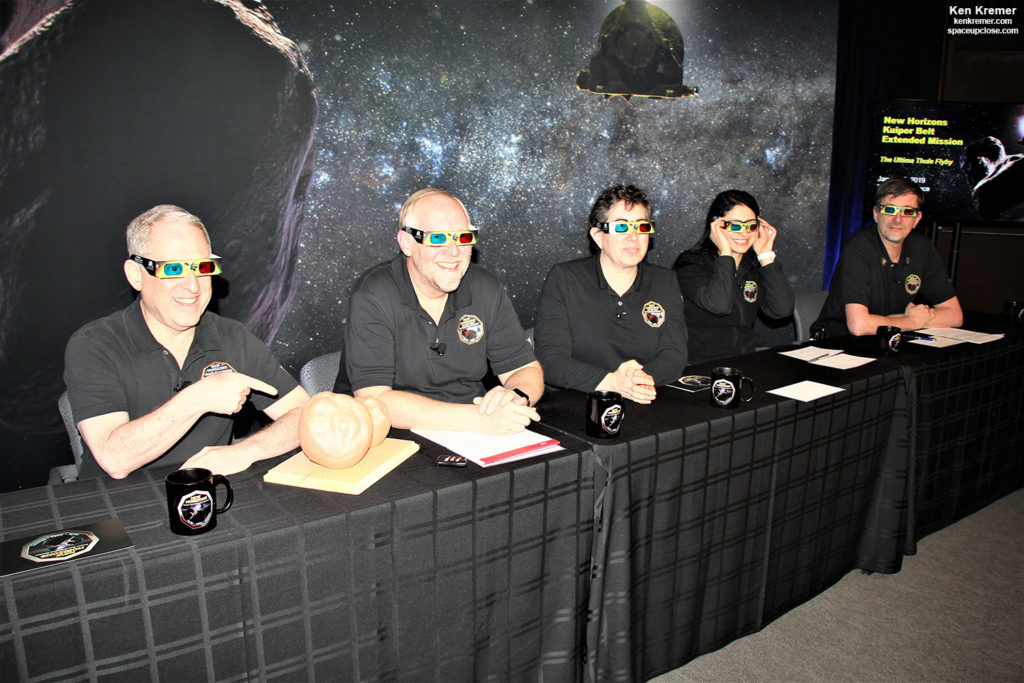RocketSTEM –3 January 2019
JOHNS HOPKINS UNIVERISTY APPLIED PHYSICS LABORATORY, LAUREL,
MD – Scientists leading NASA’s New Horizons
mission released the first 3D image of Ultima Thule at a media briefing today, Thursday,
Jan 3. after the spacecraft successfully zoomed close by during a history
making encounter on New Year’s Day.
Meanwhile the
team announced that the search for potential moons is ongoing at the farthest and
most primitive solar system object ever explored up close by a spaceship from Earth.
Ultima Thule – which
means “beyond the borders of the known world” is a Kuiper Belt object orbiting more than 4 billion miles
away from the sun!
The stereoscopic image
gives a very good sense of the three-dimensional structure of Ultima Thule
which was revealed to “look like a snowman” and discovered to be a contact binary-
the most distant ever explored.
out and wear a pair of Red-Cyan 3D anaglyph glasses to properly view the image and
experience the 3D effect.
In additional researchers
announced that no moons than
1 mile and within about 100 miles or atmosphere has been discovered
thus far in the very limited number of images transmitted back to Earth across the
vastness of 4.1 Billion miles (6.6 Billion km) of interplanetary space.
But researchers are
continuing the moon and ring search and its still possible moons may exist
further away than 100 miles, said Mark Showalter, New Horizons team member.
If they find a
moon then researchers will be able to accurately determine the mass and density
of Ultima Thule with great precision- something not possible at the moment.
All told New
Horizons gathered some 50 GB of data in the form of science and research measurements
as it flew past Ultima Thule during closest approach just
past midnight Tuesday shortly after
the dawn of New Year’s Day 2019 at 12:33 a.m. EST.
Mission scientists,
invited guests and the media including Space UpClose were on hand to witness
the groundbreaking flyby events first hand as they unfolded at the Johns
Hopkins University Applied Physics Laboratory (JHU APL), in Laurel, MD all
through the encounter period which ended today.
Check out our
gallery of on site images from JHU APL throughout the flyby and close encounter
period.
‘What a week it
has been so far. The first exploration of a small
Kuiper Belt object and the most distant exploration of any world in history is
now history, but almost all of the data analysis lies in the future,” said
Alan Stern of the Southwest Research Institute in Boulder, Colorado, at today’s
final post flyby media briefing held at the Johns Hopkins University
Applied Physics Laboratory (JHU APL), in Laurel, MD.
“As of today New Horizons spacecraft has already
journeyed over 3 million miles deeper into the Kuiper Belt.”
“The last flyby operations at Ultima Thule have
been completed. We have started new observations of other Kuiper Belt Objects
ahead.”
The 3 D image was created from a stereo pair taken by the
Long-Range Reconnaissance Imager (LORRI) at 4:23 and 5:01 Universal Time on
January 1, 2019 from respective ranges of 38,000 miles (61,000 kilometers) and
17,000 miles (28,000 kilometers), with respective original scales of 1017 feet
(310 meters) and 459 feet (140 meters) per pixel, said the team.
The team also released an animated GIF based on the two
images taken 38 minutes
apart. The smaller “Thule” lobe is closest to the New Horizons
spacecraft. As Ultima Thule is seen to rotate, hints of the topography can be
perceived, notes the team.
Dr. Brain May, Queen lead guitarist also plays a science role in
the mission as a New Horizons team member working on the 3 D images of Ultima Thule. He created
a left and right stereo image pair based on these initial two LORRI images –
see below.
“The Prize !! For those of us who waited with bated breath
for the Ultimate Stereo of Ultima Thule …,” Brian May wrote on his social
media pages.
I spoke with Brain May at a pre-flyby JHU APL briefing about
how using 3D imagery greatly helps increase public awareness and support for
space exploration and science.
for Ken’s continuing onsite coverage direct from JHU APL.
for Ken’s continuing onsite coverage of NASA, SpaceX, ULA, Boeing, Lockheed Martin,
Northrop Grumman and more space and mission reports direct from the Kennedy Space
Center, Cape Canaveral Air Force Station, Florida and Wallops Flight Facility,
Virginia.
and human spaceflight news: www.kenkremer.com –www.spaceupclose.com – twitter
@ken_kremer – email: ken at kenkremer.com
journalist and photographer based in the KSC area.
Ken’s photos are for sale and he is available for lectures and outreach events







